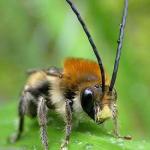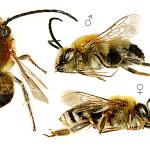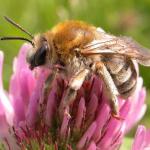Eucera tuberculata (aucct. nec FABRICIUS, 1793);
This species was previously known as E. tuberculata (F.).
Mainly south-east England, particularly Kent and East Sussex. Very rare, with no British record since J.C. Felton collected the species at Maplesden, Kent, in 1970 (Booth Museum, Brighton) and K.M. Guichard took another at Pluckley, Kent, in 1966 (Natural History Museum, London). There are several records of this species and E. longicornis being found in the same locality. Not found in Ireland. Widely distributed in Europe and North Africa (Baker 1964; Kullenberg, Buel & Tkalcu 1984, the latter providing a distribution map).
Nationally Endangered (RDB1) and thought to be extinct in Britain (Else & Spooner in Shirt 1987).
Mainly open grassland (Baker 1964). Some sites, however, were probably open clearings and rides in deciduous woodland.
Univoltine, mid June to late July. This species often begins its flight period before that of its congener E. longicornis, though there is a considerable overlap. The species is also reported to be strongly protandrous, males appearing three to four weeks before the females (Baker 1964).
No information, other than that females excavate their nest burrows in the soil.
The only flower visits in Britain are tufted vetch (Vicia cracca)(Baker 1964), bush vetch (Vicia sepium) (J C Felton, pers. comm.) and “pink clover” (Trifolium cf pratense) (specimens in the Natural History Museum, London). In Europe, it has been recorded visiting members of Asteraceae, Boraginaceae, Caryophyllaceae, Cruciferae, Euphorbiaceae, Lamiaceae, Oleaceae, Ranunculaceae and Solanaceae (Móczár 1954). Males of E. nigrescens are known pollinators of the bee orchid and late spider-orchid on mainland Europe (see notes for this behaviour in the E. longicornis profile).
On mainland Europe, the nests of this bee are attacked by the cleptoparasitic bee Nomada sexfasciata (Stöckhert 1933; Westrich 1989), though this association has not been confirmed for Britain.




